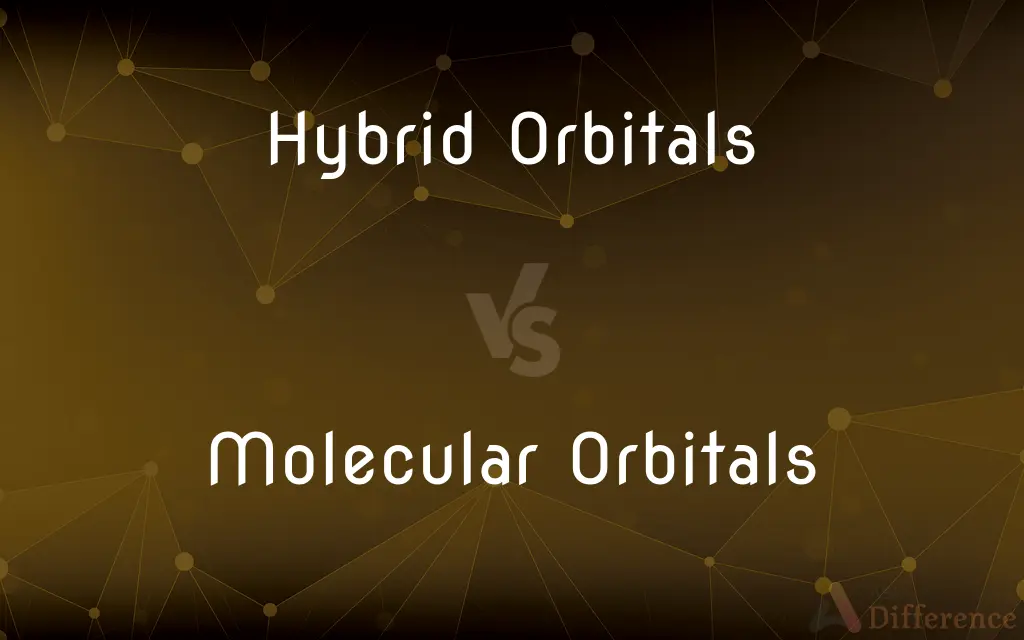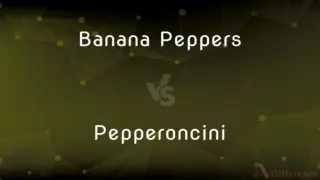Hybrid Orbitals vs. Molecular Orbitals — What's the Difference?
By Tayyaba Rehman — Published on January 9, 2024
Hybrid orbitals are combinations of atomic orbitals within an atom, while molecular orbitals extend over a molecule and describe electron behavior in molecules.

Difference Between Hybrid Orbitals and Molecular Orbitals
Table of Contents
ADVERTISEMENT
Key Differences
Hybrid Orbitals are a conceptual blend of atomic orbitals within a single atom. They form when atomic orbitals mix to create new orbitals that influence bonding characteristics, such as in the formation of sp, sp2, or sp3 hybrids. Molecular Orbitals, in contrast, are formed by the combination or overlap of atomic orbitals from different atoms when a molecule forms. They are not confined to a single atom but are spread over the entire molecule.
The concept of Hybrid Orbitals helps explain the geometry and bonding properties of molecules, such as the tetrahedral shape in methane (CH4). Molecular Orbitals provide a more comprehensive picture of how electrons are distributed in a molecule, including bonding and antibonding interactions, which is crucial in understanding molecular stability and reactivity.
Hybrid Orbitals originate from the mixing of different types of orbitals like s and p orbitals within an atom, leading to equivalent energy orbitals ideal for forming bonds. Molecular Orbitals are formed when these or other orbitals overlap between atoms, resulting in a delocalization of electrons across the molecule.
In terms of energy, Hybrid Orbitals are equivalent and lead to the formation of strong sigma bonds. Molecular Orbitals can vary in energy, with bonding orbitals being lower in energy and more stable, while antibonding orbitals are higher in energy and less stable.
The hybridization concept is vital in organic chemistry for understanding the shapes of molecules and their chemical behavior. The molecular orbital theory, on the other hand, is essential in physical chemistry for delving into the electronic structure of molecules and predicting magnetic and spectroscopic properties.
ADVERTISEMENT
Comparison Chart
Concept Origin
Mix of atomic orbitals within an atom
Overlap of atomic orbitals from different atoms
Role in Bonding
Explain geometry and bonding in molecules
Describe electron distribution in a molecule
Distribution
Confined to a single atom
Extend over the entire molecule
Types of Bonds Formed
Mainly sigma bonds
Both sigma and pi bonds
Energy Levels
Equivalent energy orbitals
Varying energy levels, including bonding and antibonding orbitals
Compare with Definitions
Hybrid Orbitals
Result from the mixing of s and p orbitals.
The sp hybrid orbitals in acetylene lead to a linear structure.
Molecular Orbitals
Can be bonding or antibonding, influencing molecular stability.
In nitrogen, the triple bond is explained by molecular orbitals.
Hybrid Orbitals
They explain molecular geometry and bonding angles.
In ethene (C2H4), the carbon atoms use sp2 hybrid orbitals.
Molecular Orbitals
Essential in physical chemistry for spectroscopic predictions.
Molecular orbital theory helps in predicting UV-Vis absorption in molecules.
Hybrid Orbitals
Crucial in organic chemistry for understanding molecular shapes.
Hybrid orbitals in benzene explain its hexagonal planar shape.
Molecular Orbitals
Describe electron behavior in molecules.
Bonding and antibonding molecular orbitals determine the stability of H2.
Hybrid Orbitals
Equal energy orbitals suitable for strong bond formation.
Hybridization in water results in bent molecular geometry.
Molecular Orbitals
Vary in energy, crucial for understanding reactivity.
Molecular orbitals in CO2 explain its linear structure.
Hybrid Orbitals
Hybrid orbitals are combinations of atomic orbitals in an atom.
The carbon atom in methane forms four sp3 hybrid orbitals.
Molecular Orbitals
Molecular orbitals extend over a molecule, formed by atomic orbital overlap.
The molecular orbitals in O2 explain its magnetic properties.
Common Curiosities
What are hybrid orbitals?
They are orbitals formed by the mixing of atomic orbitals within an atom.
What is sp3 hybridization?
A mix of one s and three p orbitals, forming four equivalent hybrid orbitals.
How do molecular orbitals differ from atomic orbitals?
They extend over a molecule and are formed by orbital overlap, unlike atomic orbitals confined to one atom.
How are molecular orbitals formed?
By the overlap of atomic orbitals from different atoms in a molecule.
Is hybridization a real physical process?
It's a conceptual model to explain molecular geometry, not a physical process.
Can a single atom have both hybrid and unhybridized orbitals?
Yes, like in ethene (C2H4), where carbon has sp2 hybrid and unhybridized p orbitals.
What is the significance of antibonding molecular orbitals?
They are higher in energy and can destabilize a molecule if occupied.
Why are hybrid orbitals important?
They help explain the geometry and bonding angles in molecules.
What do molecular orbitals tell us about a molecule?
They provide insights into electron distribution, stability, and reactivity.
Can hybrid orbitals form pi bonds?
Generally, hybrid orbitals form sigma bonds; unhybridized p orbitals form pi bonds.
Are molecular orbitals always bonding?
No, they can be either bonding or antibonding.
How does molecular orbital theory explain magnetism?
By the distribution of electrons in bonding and antibonding orbitals.
Do all molecules have hybrid orbitals?
Not all. Hybridization occurs in certain molecules, particularly in organic compounds.
How do molecular orbitals affect chemical reactions?
They influence reactivity by dictating how electrons are shared or transferred.
Is the concept of orbitals only theoretical?
While based on quantum theory, orbital concepts are supported by experimental evidence and are fundamental to understanding chemistry.
Share Your Discovery

Previous Comparison
Banana Peppers vs. Pepperoncini
Next Comparison
PGP vs. S/MIMEAuthor Spotlight
Written by
Tayyaba RehmanTayyaba Rehman is a distinguished writer, currently serving as a primary contributor to askdifference.com. As a researcher in semantics and etymology, Tayyaba's passion for the complexity of languages and their distinctions has found a perfect home on the platform. Tayyaba delves into the intricacies of language, distinguishing between commonly confused words and phrases, thereby providing clarity for readers worldwide.














































